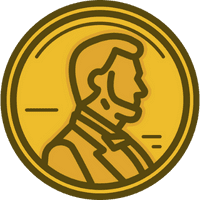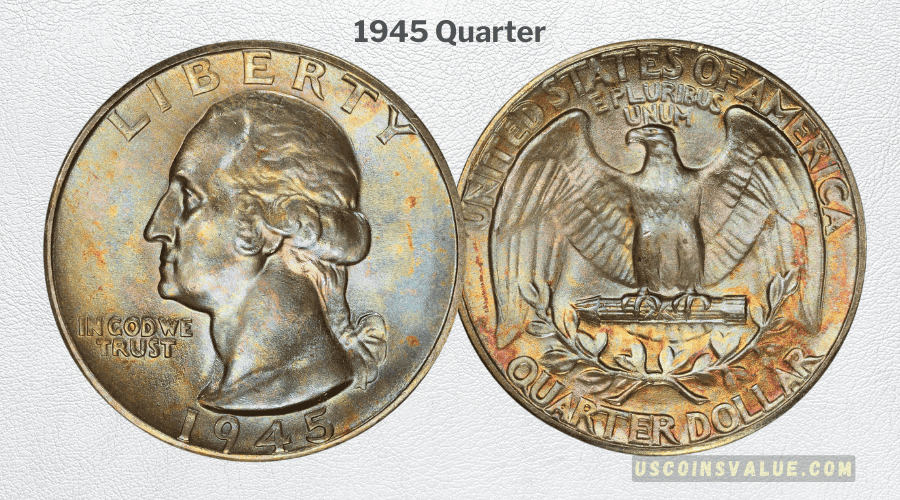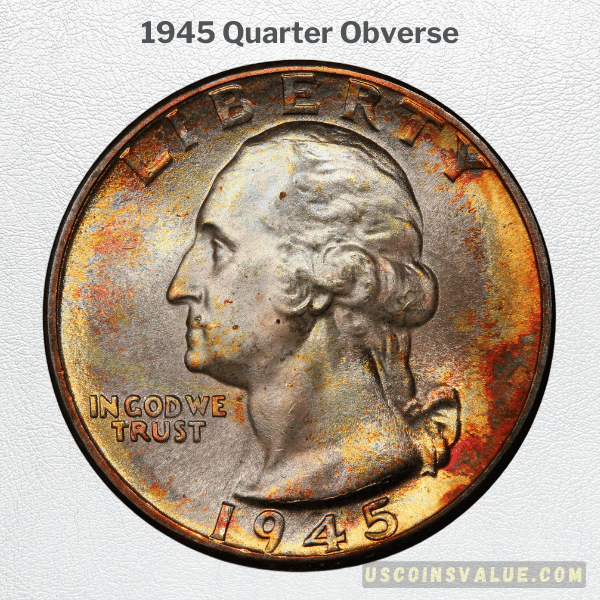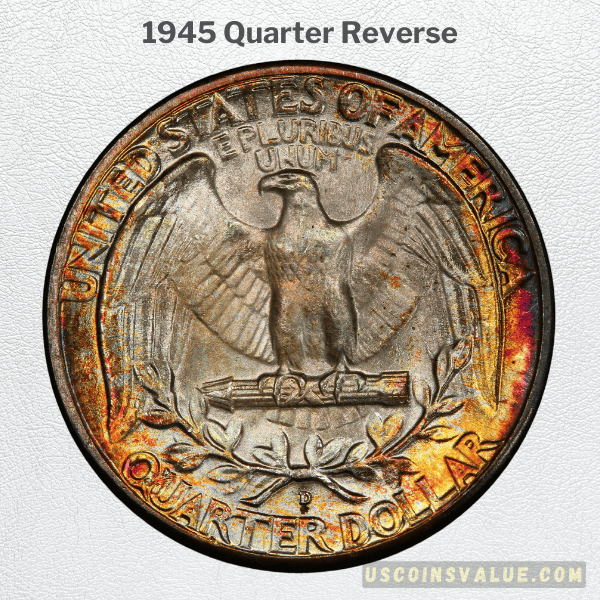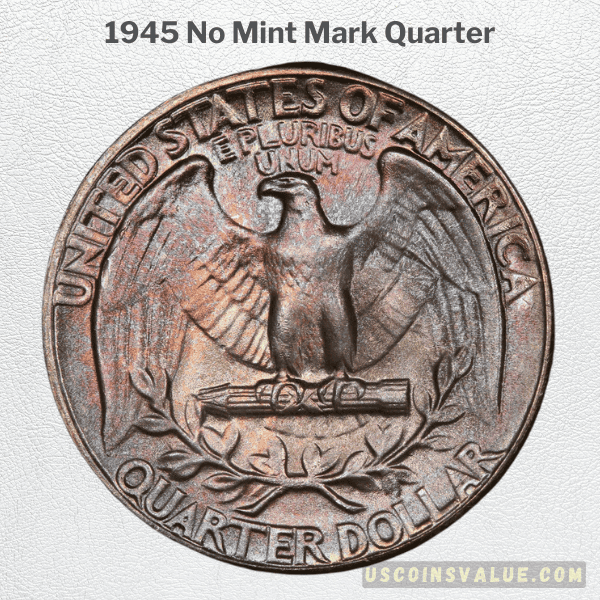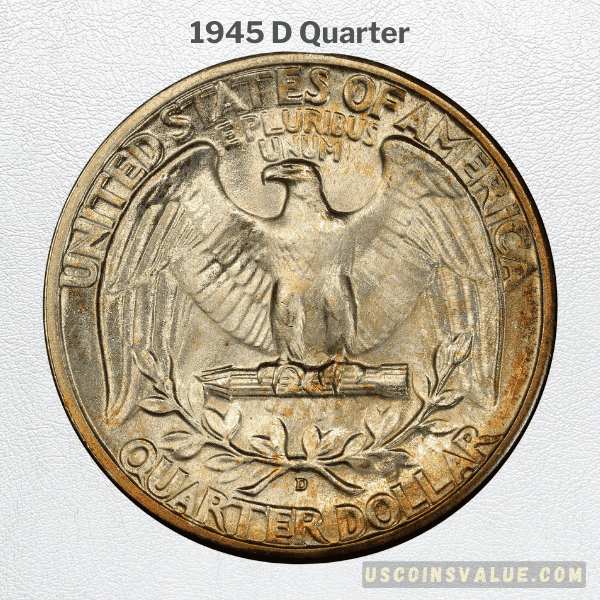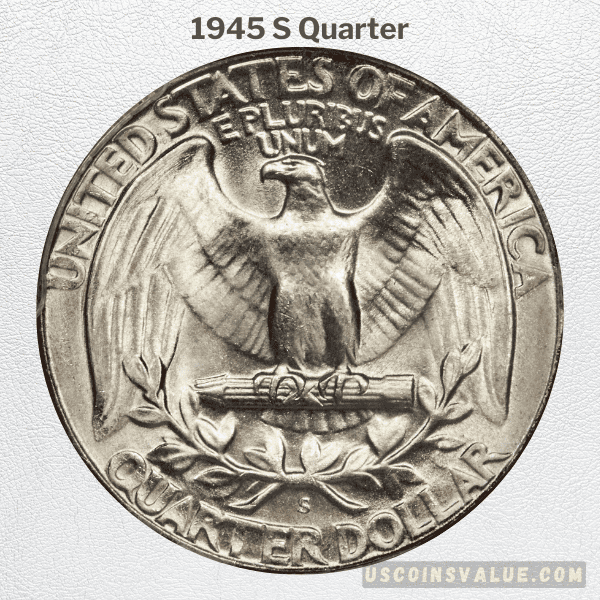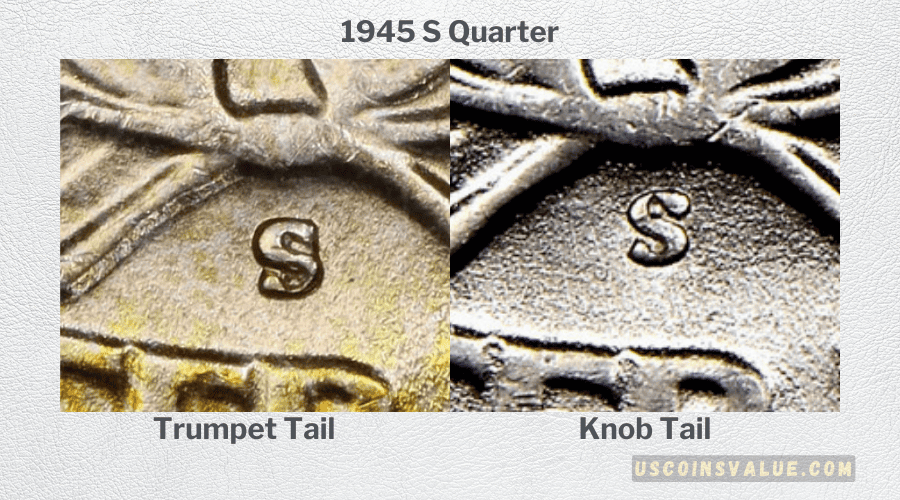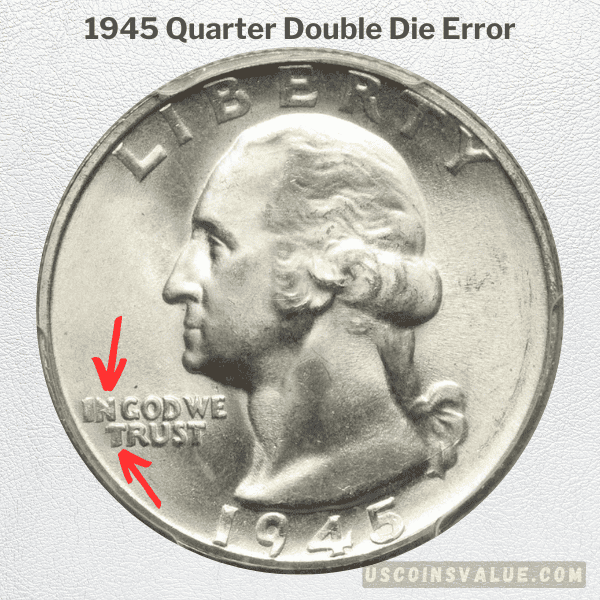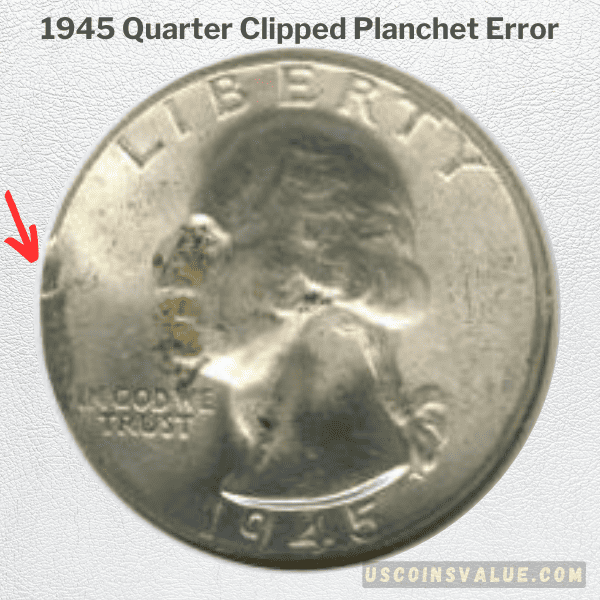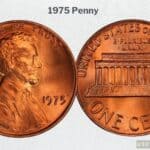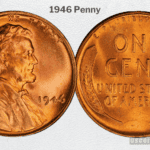Are you a collector, investor, or simply interested in the value of the 1945 quarter? Welcome to our page.
The 1945 quarter makes an interesting addition to any coin collection set. Not only does it have a rich history, but its high silver content makes it a worthy investment.
In fact, mint state pieces can be worth significant premiums, with the rarest selling for as much as $20,400. The recent recorded sale is for a 1945-S, which sold for $432 in October 2023 at Heritage Auctions.
In the following paragraphs, we will explore the 1945 silver dollar in detail. We’ll cover everything from the history, unique design, as well as the coin’s current value and market price.
So, don’t just stop here.
Dive in with us and let’s learn what makes this Washington Quarter sparkle.
Brief Background on the 1945 Quarter
Washington quarters hold a special place in the hearts of many numismatics. Minted continuously since 1932, these coins commemorated the 200th anniversary of the birth of the first President of the US. Hence the name Washington quarter series.
While many dates of the series are readily available, the 1945 Silver Quarter represents a transitional period for America. How?
Well, the US Mint struck this coin when the country was shifting from the challenges of the War to a hopeful postwar future. This historical context makes the silver dollar quite intriguing for collectors and enthusiasts.
True, the 1945 quarters might be plentiful and even available in circulation compared to earlier years. However, the 1945 issue recorded a slightly lower mintage than previous years. In the following years, the mintage of these quarters increased due to increased demand for coinage after WW2.
Unlike modern Washington quarters, the 1945 silver coins feature a silver composition made up of 90% silver and 10% copper. This distinct alloy, coupled with the perceived scarcity of the 1945 issue, impacts the coin value significantly.
Although the government removed the 1945 quarters from circulation, they remain a federally recognized legal tender. That explains why you can still find them in your pocket change.
Key Details About the 1945 Quarter
Design of the 1945 Quarter
Even after the end of war, the US government maintained the iconic design of the first Washington Quarter introduced in 1932.
The 1945 quarter rocks John Flanagan’s design that features the stylish profile of America’s first President, George Washington facing right on the obverse side.
The New York sculptor placed the word “LIBERTY” arched above Washington’s head to signify the country’s core values.
Just below the later president’s chin, the motto “IN GOD WE TRUST” dominates the space, conveying faith in the almighty father guiding the nation. The production date “1945” completes the coin’s obverse design.
As for the reverse, the key centerpiece is the bold American eagle at the center. The nation’s official bird clutches arrows, displaying America’s strength. Below the eagle, you can see an olive branch that signifies the country’s desire for peace.
As for the inscription, they read:
- UNITED STATES OF AMERICA
- E PLURIBUS UNUM
- QUARTER DOLLAR MARK
Mintmarks and Mintage
After the hiatus during World War II, the US government resumed minting the Washington Quarter vigorously in 1945.
They struck the coins in three minting facilities across the US, namely: Philadelphia, Denver, and San Francisco.
The Denver and San Francisco issues had the “D” and “S” mintmark, respectively. However, pieces from the Philadelphia Mint lacked the mint mark.
As for production, the Philadelphia facility churned out the highest number of quarters, producing over 74 million pieces. The other two centers had more modest output.
The table provides you with a clear summary of the overall mintage recorded in the three centers:
| Minting Location | Mintage |
| Philadelphia | 74,372,000 |
| Denver | 12,341,600 |
| San Francisco | 17,004,001 |
Additional Details
- Category: Washington Quarters (1932-1998)
- Mint: Philadelphia, Denver, and San Francisco
- Mintage: 86,713,600
- Obverse and Reverse Designer: John Flanagan
- Composition: Silver
- Fineness: 0.9
- Weight: 6.25g
- ASW: 0.18080z
- Diameter: 24.3mm
- Edge: Reeded
- Melt Value: $4.14
Are 1945 Quarters Worth Anything Today?
The 1945 Silver Quarter might look like any modern Washington Quarter, but there’s more to it than meets the eye.
As a baseline, circulated coins sell anywhere from $3 to $5, which is significantly higher than their face value of $0.25. Remember, these values increase depending on several factors, including the coin’s condition (or grade), rarity, and mint mark.
Let’s look at the condition.
1945 quarters in mint state or uncirculated conditions, especially those at MS65 and above, often demand higher prices. The reason is that these pieces display minimal wear and have full design details and good luster.
If you’re looking to buy some 1945 quarters for your coins collections, expect to spend around $10 to $20. But if you’ve got some money to burn and need something that packs some oomph behind, look for varieties with errors as their value usually increases over time.
That said, here’s a breakdown of the current market prices for the 1945 quarters:
| 1945 Washington Quarter Value Chart | ||||
| Mint Mark | Condition | |||
| Circulated | Uncirculated | MS60–MS65 | MS66–MS68 | |
| 1945 “No mint mark” Washington Quarter | $5 | $6 – $8.50 | $7 – $13 | $55 – $8,500 |
| 1945 “D” Washington Quarter | $4 | $6–8.50 | $7 -$35 | $45 – $16,000 |
| 1945 “S” Washington Quarter | $4 | $6 – $8 | $7 – $35 | $50 – $300+ |
Still, on values, let’s explore how much 1945 quarter varieties demand on the open market.
1945 No Mint Mark Quarter
As mentioned earlier, the Philadelphia Mint recorded the highest mintage in 1945. So, issues from this mint are relatively common and affordable, particularly in low and average conditions. These fetched between $5 to $10 at auction, thanks to their high silver composition.
However, 1945 “no mint mark” coins are a bit tougher to find in a GEM condition and quite valuable to collectors. Mint state pieces–around MS65+ – often command a higher price from $50 to upwards of a few thousand dollars based on their quality.
But pieces with well-struck features and full luster appeal more to numismatics and sell for much more money. For example, the finest known 1945 “no mint mark” quarter graded at MS68 fetched around $16,450 in 2015.
Today, in 1945, Philadelphia quarters graded MS67 sell for $300 to $600. Here are other examples of this 1945 quarter variety and their prices.
| Grade | Price | Auction House | Date |
| MS 64 | $70 | David Lawrence RC | Jan-2023 |
| MS 65 | $552 | Heritage Auctions | March-2018 |
| MS 66 | $70 | David Lawrence | Nov-2022 |
| MS 66+ | $94 | Heritage Auctions | Aug-2022 |
| MS 67 | $324 | Heritage Auctions | May-2023 |
| MS 67+ | $2,280 | Stack’s Bowers | March-2021 |
| MS68 | $1,860 | Heritage Auctions | Feb-2022 |
1945 D Quarter
With a mintage of 12.3 million, the Denver mint had the lowest output of Washington Quarters in 1945. But don’t be fooled by these low numbers–the 1945-D silver dollars are common up through MS67 grade.
However, at MS68, these quarters become extremely rare. Often, these 1945-D coins showcase better strikes and luster, unlike their Philadelphia and San Francisco cousins from the same year.
In circulated condition, the 1945-D Washington quarters cost slightly higher than their face value–around $4 to $7. But once you get to MS67 and higher grades, the coins take a whole new level of value. Not to mention the appeal.
Examples in these grades can fetch as much as $12,750 or more. According to auction records, a 1945-D with MS68 condition sold for an impressive price of $20,400 in 2021. In the most recent records, two similar coins graded at MS67 sold for $1,260 and $300 in 2022 and 2023, respectively.
Check out the table below for more price information for the 1945-D quarters.
| Grade | Price | Auction House | Date |
| MS 65 | $40 | David Lawrence RC | Aug-2022 |
| MS 66 | $100 | Stack’s Bowers | May-2023 |
| MS 67 | $312 | Heritage Auctions | Mar-2023 |
| MS 67 | $240 | Heritage Auctions | Dec-2022 |
| MS 67+ | $1,200 | Stack’s Bowers | Mar-2021 |
| MS67+ | $900 | Stack’s Bowers | Mar-2021 |
1945 S Quarter
In the final year of WW2, the San Francisco minting facility ramped up its quarter production, increasing output by 50% from the previous year.
The mint struck around 17 million pieces, most of which were saved in BU rolls by collectors and coin enthusiasts at the time. However, these coins had inconsistent quality. Even in GEM conditions, they exhibit weak strikes.
There are two varieties of the 1945-S quarters: the Trumpet Tail S and Knob Tail S, but neither carries a premium.
You can find the 1945-S silver coins through all grades up to MS67. But examples graded at MS68 and above are rare and sought after by collectors.
As for price, NGC price records say that 1945-S quarters sell for $4.70 to $7.25 in circulated condition. In uncirculated conditions, the coins could fetch a high price of up to $13,000. A good example is this 1945-S quarter with MS67 grade, which sold for a modest price of $7,200.
| Grade | Price | Auction House | Date |
| MS 66 | $51 | Heritage Auctions | Jun-2023 |
| MS 67 | $432 | Heritage Auctions | Oct-2023 |
| MS 67 | $372 | Heritage Auctions | Aug-2023 |
| MS 67+ | $1,380 | Heritage Auctions | May-2022 |
| MS67+ | $1,620 | Heritage Auctions | Feb-2022 |
Do the 1945 Quarter Have Any Rare Errors?
The 1945 quarter series seems short of known errors, unlike its counterparts from the previous years. But don’t let this stop you from keeping an eye out for the following minor, unclassified errors:
Double Die Error
One exciting error that collectors often search for in Washington quarters is the elusive double die error. It occurs when a coin is struck the second time by the pressing machine, creating a doubling of design elements.
While the doubling might not be visible in some coins, in others it can be pronounced, almost 3D-like with impressions from the dies.
Sure! Dramatic double-die quarters are rare, but that’s what makes finding one exciting. The value of such error coins can reach thousands. Of course, the coins must have strong visual appeal.
This 1945-S graded at MS66 is a good example. Because of the doubling of the design elements on the Obverse, a collector paid $1,527 for it in 2015.
Clipped Planchet Error
At first glance, a Washington Quarter with a clip planchet error might seem disappointing. After all, who wants a coin missing a whole chunk of its design?
Well, that’s where most people are wrong. Coin error enthusiasts fancy the “bite-like mark” on the coin and some will pay more for the quarter.
A clip planchet error happens when the mint strikes a blank planchet with a damaged edge. The error can appear as a curved, straight, or bowtie shape. Usually, the mint re-melt and re-strike these error coins, but sometimes a few specimens escape into circulation.
So, how much can a quarter with these errors fetch?
Auction records show that 1945 quarters with a clipped planchet error can sell for $41 or more.
Summary
That’s it for today. We hope you found this guide fun and informative. But before you go, let’s get a recap of what we have learned.
The 1945 quarter is common in circulated conditions. However, in higher grades–MS67 and above–they become scarce and offer many opportunities for collectors. Die varieties and errors also add to the excitement of the collection.
With the value of silver increasing, expect the demand and value of the 1945 quarter to increase too. So, start looking through your pocket change or coin jar for these unique and fascinating coins. Who knows! You might uncover the lucky piece.
